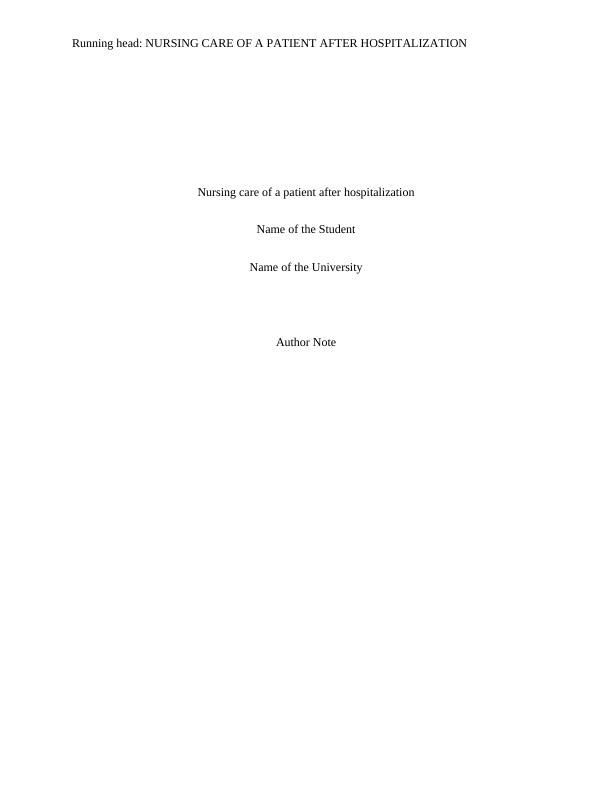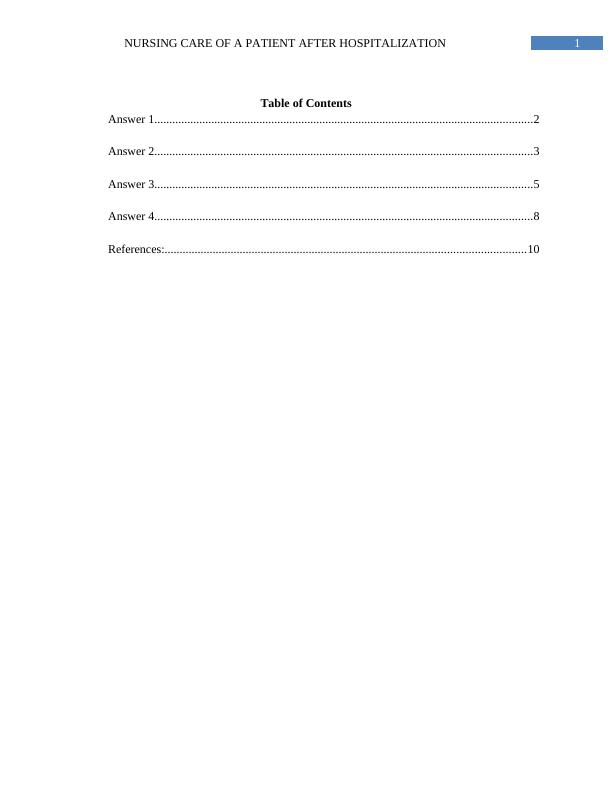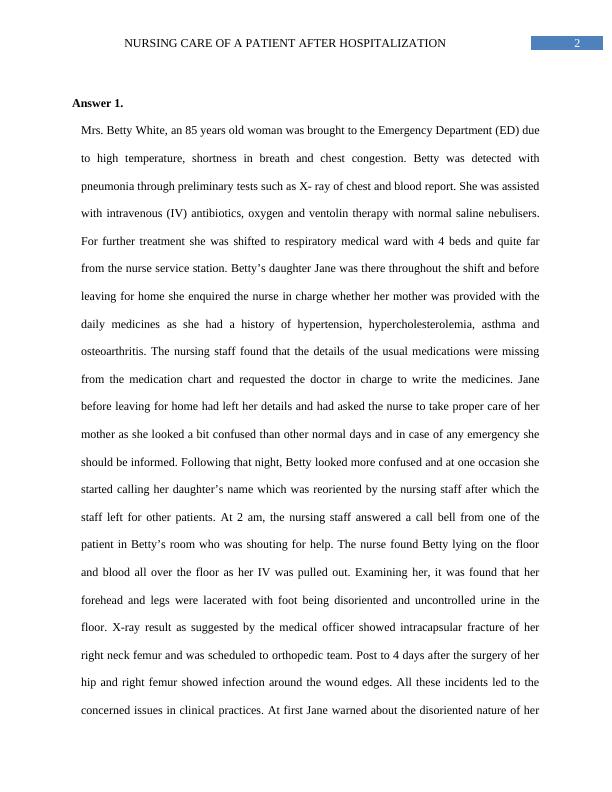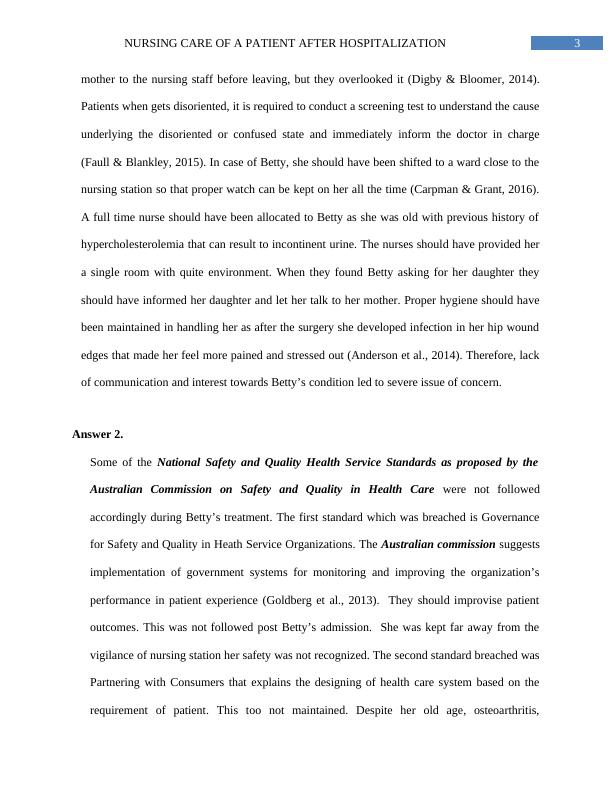NRSG353 - Nursing Care of a Patient After Hospitalization
Added on 2020-03-04
13 Pages3566 Words87 Views
Running head: NURSING CARE OF A PATIENT AFTER HOSPITALIZATIONNursing care of a patient after hospitalizationName of the StudentName of the UniversityAuthor Note

1NURSING CARE OF A PATIENT AFTER HOSPITALIZATIONTable of ContentsAnswer 1..............................................................................................................................2Answer 2..............................................................................................................................3Answer 3..............................................................................................................................5Answer 4..............................................................................................................................8References:........................................................................................................................10

2NURSING CARE OF A PATIENT AFTER HOSPITALIZATIONAnswer 1.Mrs. Betty White, an 85 years old woman was brought to the Emergency Department (ED) dueto high temperature, shortness in breath and chest congestion. Betty was detected withpneumonia through preliminary tests such as X- ray of chest and blood report. She was assistedwith intravenous (IV) antibiotics, oxygen and ventolin therapy with normal saline nebulisers.For further treatment she was shifted to respiratory medical ward with 4 beds and quite farfrom the nurse service station. Betty’s daughter Jane was there throughout the shift and beforeleaving for home she enquired the nurse in charge whether her mother was provided with thedaily medicines as she had a history of hypertension, hypercholesterolemia, asthma andosteoarthritis. The nursing staff found that the details of the usual medications were missingfrom the medication chart and requested the doctor in charge to write the medicines. Janebefore leaving for home had left her details and had asked the nurse to take proper care of hermother as she looked a bit confused than other normal days and in case of any emergency sheshould be informed. Following that night, Betty looked more confused and at one occasion shestarted calling her daughter’s name which was reoriented by the nursing staff after which thestaff left for other patients. At 2 am, the nursing staff answered a call bell from one of thepatient in Betty’s room who was shouting for help. The nurse found Betty lying on the floorand blood all over the floor as her IV was pulled out. Examining her, it was found that herforehead and legs were lacerated with foot being disoriented and uncontrolled urine in thefloor. X-ray result as suggested by the medical officer showed intracapsular fracture of herright neck femur and was scheduled to orthopedic team. Post to 4 days after the surgery of herhip and right femur showed infection around the wound edges. All these incidents led to theconcerned issues in clinical practices. At first Jane warned about the disoriented nature of her

3NURSING CARE OF A PATIENT AFTER HOSPITALIZATIONmother to the nursing staff before leaving, but they overlooked it (Digby & Bloomer, 2014).Patients when gets disoriented, it is required to conduct a screening test to understand the causeunderlying the disoriented or confused state and immediately inform the doctor in charge(Faull & Blankley, 2015). In case of Betty, she should have been shifted to a ward close to thenursing station so that proper watch can be kept on her all the time (Carpman & Grant, 2016).A full time nurse should have been allocated to Betty as she was old with previous history ofhypercholesterolemia that can result to incontinent urine. The nurses should have provided hera single room with quite environment. When they found Betty asking for her daughter theyshould have informed her daughter and let her talk to her mother. Proper hygiene should havebeen maintained in handling her as after the surgery she developed infection in her hip woundedges that made her feel more pained and stressed out (Anderson et al., 2014). Therefore, lackof communication and interest towards Betty’s condition led to severe issue of concern.Answer 2.Some of the National Safety and Quality Health Service Standards as proposed by theAustralian Commission on Safety and Quality in Health Care were not followedaccordingly during Betty’s treatment. The first standard which was breached is Governancefor Safety and Quality in Heath Service Organizations. The Australian commission suggestsimplementation of government systems for monitoring and improving the organization’sperformance in patient experience (Goldberg et al., 2013). They should improvise patientoutcomes. This was not followed post Betty’s admission. She was kept far away from thevigilance of nursing station her safety was not recognized. The second standard breached wasPartnering with Consumers that explains the designing of health care system based on therequirement of patient. This too not maintained. Despite her old age, osteoarthritis,

End of preview
Want to access all the pages? Upload your documents or become a member.
Related Documents
NURSING CASE STUDY 9 Nursing Case Study Name of the University: Mrs Betty Whitelg...
|11
|2953
|230
Nurses' Case Study: An Example of a Student Namelg...
|13
|3510
|230
Nursing Assignment: Clinical Issues and NMBA Standardslg...
|9
|2024
|272
Problem Solving with the Reference of a Case Studylg...
|7
|1791
|138
Case Study | The emergency department with pneumonia and a chest infection.lg...
|7
|1731
|18
Introduction Nurses Play a Critical Role Assignment 2022lg...
|7
|2121
|30
